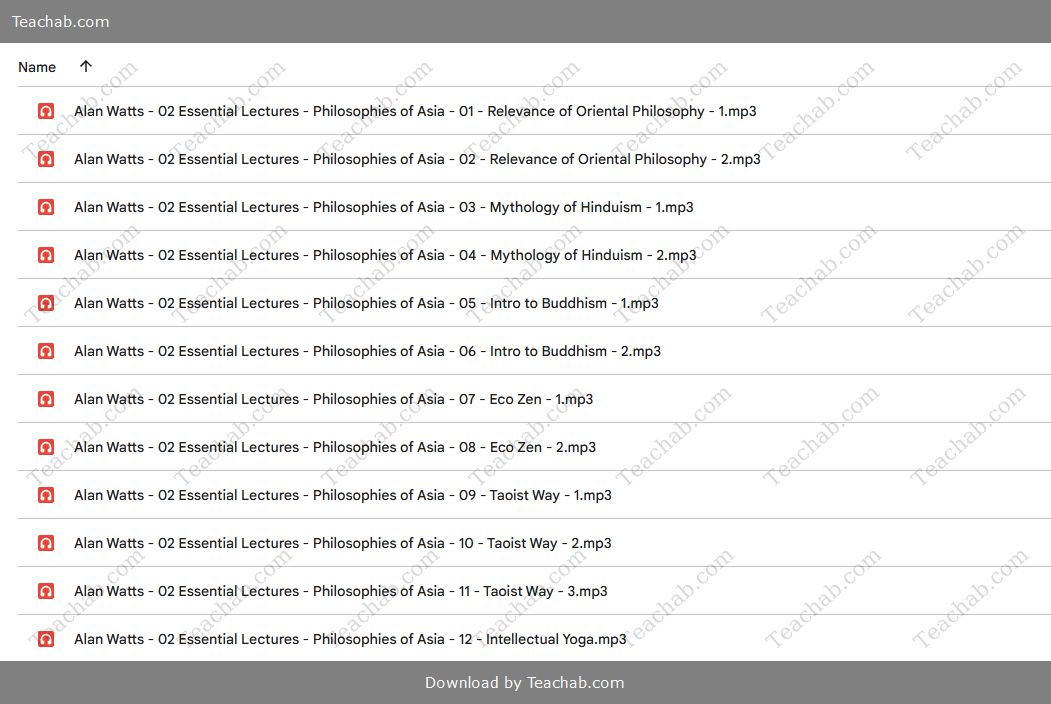Philosophies of Asia
by Alan Watts
Get Philosophies of Asia by Alan Watts Digital Download!
You can check proof of content here

Philosophies of Asia by Alan Watts
Overview

An In-Depth Review of "The Philosophies of Asia" by Alan Watts
The Philosophies of Asia by Alan Watts is a thought-provoking collection of lectures that introduces readers to various Eastern philosophies. This work captures the essence of Indian, Chinese, and other Asian philosophical traditions, making these ideas more accessible to Western audiences. Though it may not provide the depth needed for academic study, Watts’s engaging and humorous style offers a broad overview of Asian thought, contrasting it effectively with Western religious traditions. Through this work, Watts invites readers to rethink their understanding of existence, divinity, and the cosmos, using his signature wit and clarity to make complex philosophical concepts approachable.
Watts’s discussions are not confined to academic analysis; rather, he brings deep and relatable insights into ancient traditions. He offers clear interpretations of Eastern philosophies, focusing on their differing views of divinity, which serve as the basis for a richer understanding of the universe. The following sections will break down the key themes and contributions of the book to modern philosophy.
Contrasting Views of Divinity: East vs. West
A central theme in The Philosophies of Asia is the differing views on divinity in Eastern and Western traditions. In many Western religious frameworks, God is typically envisioned as a separate, sovereign being—transcendent and all-powerful. This portrayal of God promotes a hierarchical worldview, separating humanity from the divine.
On the other hand, Watts introduces a contrasting Eastern view where divinity is seen as omnipresent, interwoven within the fabric of the universe. In Hinduism, for example, divinity is not distant but instead inhabits all of creation. The universe is described as a cosmic stage, where God enacts the drama of existence by dreaming all beings into life. This idea reflects the interconnectedness of all things.
Similarly, in Taoism, the divine is not external but inherent in the natural world. The Tao represents the underlying flow of the universe, and humans are encouraged to live in harmony with this flow. In both Hinduism and Taoism, divinity is an intimate and inseparable part of the natural world, fostering a more holistic sense of interconnectedness.
Structure and Themes of the Book
The Philosophies of Asia is organized around a series of lectures that address different aspects of Eastern thought. Each lecture invites readers to explore themes such as reality, consciousness, and human nature, offering new perspectives on familiar concepts. Some of the key topics include The Mythology of Hinduism, Eco-Zen, Intellectual Yoga, and Introduction to Buddhism. Each section engages with a particular philosophical tradition, offering both insights and opportunities for reflection.
In his lecture on Eco-Zen, Watts explores the profound connection between individuals and their environments, challenging the notion that humans exist in isolation from nature. This idea ties into modern ecological concerns, showing how Eastern philosophies can provide valuable insights into environmental ethics. By presenting humans as integral parts of the ecosystem, Watts underscores the importance of harmony—not only among people but with the natural world as well.
In The Mythology of Hinduism, Watts dives into the rich symbolic universe of Hindu deities and narratives. His ability to convey complex concepts in an easily digestible way makes this lecture especially engaging for those unfamiliar with the subject. Through storytelling, he makes abstract ideas accessible, helping readers grasp the deeper meanings behind Hindu mythology without getting bogged down in technical language.
The Transformative Nature of Eastern Philosophy
A significant aspect of Watts's philosophy is his focus on transformation rather than rigid dogma. Unlike many Western religious traditions, which emphasize prescribed beliefs and divine revelations, Eastern philosophies encourage self-exploration and direct experience. Watts presents these traditions as pathways to personal transformation, where individuals actively engage with reality in a dynamic and evolving way.
In his discussion of Buddhism, Watts emphasizes mindfulness as a tool for transforming consciousness. He explains that rather than adhering to strict doctrines, Buddhism encourages individuals to experience life firsthand, cultivating mindfulness and awareness that lead to enlightenment. This approach challenges the more dogmatic structures found in many Western philosophies, advocating instead for a more experiential understanding of existence.
Watts also challenges conventional moral frameworks, suggesting that ethical living is not about following external rules but arises from a deeper understanding of the interconnectedness of all beings. By encouraging readers to see themselves as participants in the cosmic flow, he opens up the possibility for a morality rooted in compassion and empathy rather than in rigid systems of right and wrong.
Engaging Style and Accessibility
One of the standout qualities of The Philosophies of Asia is Watts's engaging, accessible writing style. His use of humor, metaphors, and vivid anecdotes brings complex philosophical ideas to life, making them relatable to a wide range of readers. This approach allows readers with no prior background in philosophy to grasp deep concepts without feeling overwhelmed.
For instance, when explaining the interconnectedness of existence, Watts often uses metaphors that connect to everyday life. He compares the universe to a vast tapestry, where each individual thread remains distinct yet contributes to the larger pattern. This metaphor provides a visual way to understand how we fit into the greater whole of existence, emphasizing both individuality and interconnectedness.
Furthermore, Watts’s conversational tone helps demystify philosophical topics. He invites readers to think critically about their beliefs and explore new perspectives, fostering an environment where ideas can be questioned, tested, and ultimately integrated into one’s worldview.
Conclusion: Watts’s Lasting Legacy and Invitation for Exploration
In conclusion, The Philosophies of Asia is a valuable introductory text that opens the door to the world of Eastern philosophy. While it may not offer the depth that academic studies demand, its engaging and accessible style provides readers with a framework to think more deeply about life, existence, and divinity. Watts’s work serves as an invitation for readers to explore Eastern thought more thoroughly, offering fresh perspectives on the interconnectedness of all things.
Through his teachings, Watts has left a lasting impact, making the profound ideas of Eastern philosophies accessible to a contemporary audience. His work continues to inspire seekers of wisdom, encouraging them to explore and reflect on the wisdom of diverse traditions. By engaging with the philosophical concepts presented in The Philosophies of Asia, readers can embark on a journey not only toward intellectual enlightenment but also toward personal transformation.




